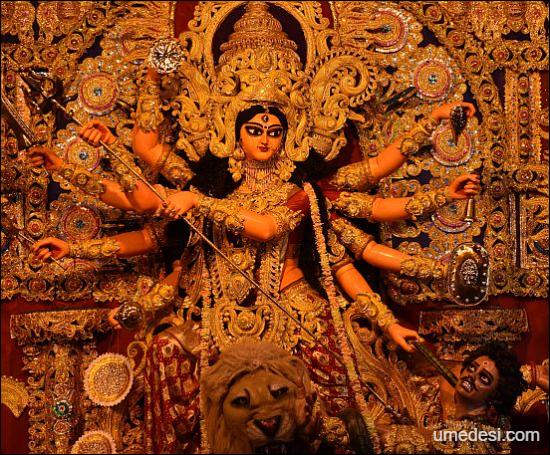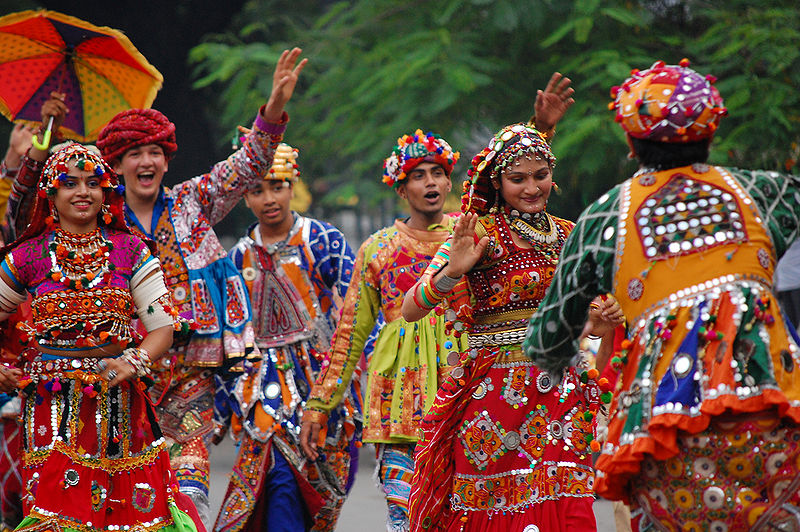India, the land known for her rich cultural tapestry, and her people celebrate a multitude of festivals to celebrate life, spirituality, and universal peace. Among these, Navaratri stands out as a vibrant and spiritually significant nine-night festival. Navaratri, which translates to “nine nights” in Sanskrit, is a time for devout worship, energetic dance, and culinary feasts. Let’s explore Navaratri in India.
NavaRatri – A Nine Day festival
Each day of this festival has a specific purpose and is dedicated to a different form of Mother Goddess Durga in all of her splendor.

Day 1: Pratipada – Goddess Shailaputri
The first day of Navaratri, is in the honor of Goddess Shailaputri, the daughter of the mountains. She symbolizes purity and the power of nature. According to the stories, she is the reincarnation of Goddess Sati, the first consort of Lord Shiva.
Day 2: Dwitiya – Goddess Brahmacharini
Goddess Brahmacharini, worshipped on the second day, is an epitome of penance and devotion. She represents the pursuit of truth and knowledge. Her name signifies one who practices devout celibacy.
Day 3: Tritiya – Goddess Chandraghanta
On the third day, we venerate Goddess Chandraghanta, a symbol of bravery and grace. Her name derives from her half-moon-shaped bell (ghanta) and her fierce demeanor while fighting evil forces.
Day 4: Chaturthi – Goddess Kushmanda
Goddess Kushmanda, celebrated on the fourth day, is the creator of the universe. She is believed to have created the world by a mere smile. Her name signifies her power to provide warmth and energy.
Day 5: Panchami – Goddess Skandamata
Goddess Skandamata, revered on the fifth day, is the mother of Lord Kartikeya (Skanda), the god of war. She symbolizes motherly love, protection, and divine maternal instincts.
Day 6: Shashti – Goddess Katyayani
The sixth day honors Goddess Katyayani, a fierce warrior who emerged from the anger of the gods. She embodies strength, courage, and fearlessness.
Day 7: Saptami – Goddess Kalaratri
Goddess Kalaratri, worshipped on the seventh day, is the destroyer of darkness and ignorance. She is the fierce form of Goddess Parvati, symbolizing the triumph of light over darkness.
Day 8: Ashtami – Goddess Mahagauri
Goddess Mahagauri, on the eighth day, represents purity and serenity. She is depicted in a white attire, symbolizing her divinely peaceful nature.
Day 9: Navami – Goddess Siddhidatri
On the final day, we revere Goddess Siddhidatri, the bestower of supernatural powers. She signifies the fulfillment of desires and the ultimate achievement of spiritual enlightenment.
Festival traditions across India
Navaratri is also associated with Dussehra or Dasara in many parts of India, particularly in the southern regions. These festivals are related and mark the victory of good over evil, but they have distinct names and significance.
Navaratri
Navaratri, which means “nine nights” in Sanskrit, is a festival celebrated over nine nights and ten days. It honors the divine feminine energy, especially Goddess Durga, who is worshipped in various forms during this period. The festival is dedicated to the triumph of good over evil. Each day of Navaratri is associated with a specific form of the goddess and has its own significance.
Durga Puja
Embed from Getty ImagesIn West Bengal, Navaratri culminates in the grand Durga Puja festival. Elaborate idols of Goddess Durga are crafted and worshipped with great pomp and splendor. The festival is marked by processions, music, and cultural performances.
Dussehra or Dasara
Dussehra, also known as Dasara in some regions, is the culmination of Navaratri and typically falls on the tenth day. It is a major festival celebrated with great fervor. The word “Dussehra” is derived from Sanskrit and means “remover of bad fate” (dus – bad; sehra – fate).
Vijayadashami
Vijayadashami is another name for Dussehra, and it has profound significance. “Vijaya” means victory, and “dashami” refers to the tenth day of the lunar calendar. On this day, it is believed that Lord Rama, an avatar of Lord Vishnu, defeated the demon king Ravana, who had abducted Rama’s wife, Sita. It marks the victory of righteousness (dharma) over evil (adharma).
The story of Vijayadashami revolves around Lord Rama’s return to Ayodhya after his 14-year exile and his victory over Ravana. The people of Ayodhya celebrated his return by lighting lamps, which is why Diwali, the festival of lights, is also associated with this occasion.
Mahishasura Mardini
Mahishasura Mardini is a significant aspect of Goddess Durga. The name “Mahishasura Mardini” means “the slayer of the buffalo demon.” According to Hindu mythology, the demon king Mahishasura was causing havoc in the universe. Unable to defeat him, the gods invoked the divine feminine energy, and Goddess Durga emerged to confront and defeat Mahishasura in a fierce battle.
This story symbolizes the triumph of good (Goddess Durga) over evil (Mahishasura). During Navaratri, especially in South India, the goddess is worshipped as Mahishasura Mardini, signifying her role as the vanquisher of evil forces.
Ayudha Puja
One of the prominent traditions during Dussehra is the Ayudha Puja. Also known as Astra Puja or Shastra Puja, is a significant ritual in South India that involves the worship of tools, instruments, and vehicles.
While “Ayudha” does indeed mean “weapon” in Sanskrit, this puja is not limited to just weapons; it encompasses a wide range of objects and tools that are essential in people’s daily lives.
Ayudha Puja is a gesture of respect towards the tools and equipment that play a vital role in our daily lives. It emphasizes the idea of using our skills and tools responsibly and with gratitude.
Saraswati Puja
Embed from Getty ImagesIn some regions, Dussehra marks the end of the Navaratri celebrations with Saraswati Puja. Goddess Saraswati, the deity of knowledge and learning, is revered on this day.
Saraswati Puja during Navaratri usually performed on the 7th day (Saptami) or 9th day (Navami) of the festival, depending on local traditions, holds special significance for students as it aligns with the belief that invoking the goddess’s blessings during this auspicious period can enhance their academic pursuits and creative endeavors.
Books, musical instruments, and educational tools are kept in front of the goddess and worshipped. Students seek her blessings for academic success.
While Navaratri is celebrated across India, its essence and rituals vary from region to region.
Navaratri Traditions and Customs
Navaratri is a time of spiritual reflection, devotion, and celebration. Here are some key traditions and customs associated with this festival:
Garba and Dandiya Raas
Garba is a traditional Gujarati dance performed in a circular formation. Dancers move gracefully to the beat of traditional folk songs, often accompanied by claps and twirls. It symbolizes the circular path of life.

Dandiya Raas involves dancers wielding colorful sticks (dandiyas) in pairs. This lively dance signifies a mock-fight between the Goddess and the demon king.
Embed from Getty ImagesGolu or Bommai Kolu or Bommala Koluvu

Golu, also known as Bommai Kolu in Tamil Nadu and Gombe Habba in Karnataka, and Koluvu in Andhra Pradesh, is a significant tradition in South India, particularly during the Navaratri festival.
Families create Golu displays. Golu consists of arranging dolls and figurines in tiers or steps. Each step narrates a story or theme, often featuring deities and mythological scenes.
The topmost step usually features idols of deities, particularly Goddess Saraswati, Lakshmi, and Durga during Navaratri. Other steps may showcase scenes from epics like the Ramayana or Mahabharata, miniature village setups, and depictions of daily life.
Ram Lila
Embed from Getty ImagesRam Lila is a dramatic reenactment of episodes from the Ramayana, particularly the story of Lord Rama’s victory over Ravana.
On the final day of Durga Puja, effigies of Ravana, his brother Kumbhakarna, and his son Meghanada (Indrajit) are burned in a symbolic act of the victory of Lord Rama over Ravana. This event, known as Ravana Dahan, draws large crowds and is accompanied by fireworks.
Fasting and Prayer
Many devotees observe fasts during Navaratri. Some opt for a complete fast, while others consume fruits, milk, and light meals. Fasting is seen as a way to purify the body and soul.
Prayers and bhajans (devotional songs) are an integral part of Navaratri. Devotees visit temples and offer their reverence to the goddess.
Traditional Foods and Offerings
Navaratri is a gastronomic delight with a variety of dishes prepared across India. Here are some popular dishes and treats served during this festive season:
Sundal – South Indian Chickpea Salad
A South Indian delicacy, Sundal is a protein-packed snack made from boiled chickpeas or lentils. It’s seasoned with mustard seeds, curry leaves, and grated coconut, making it a healthy and delicious offering during the festival.
Payasam (South Indian) Or Kheer (North India) – Rice Dessert
Payasam or kheer is a sweet rice dish made with milk, rice, and flavored with cardamom and saffron. It’s a favorite dessert in all of India. Traditionally made with Jaggery.
Kuttu Ki Puri – Buckwheat Puri
A North Indian fasting favorite, Kuttu Ki Puri is made from buckwheat flour and deep-fried until it puffs up. It’s served with potato curry.
Sabudana Khichdi – Tapioca Pearl Stir-Fry
This Maharashtrian dish features tapioca pearls stir-fried with peanuts, curry leaves, and spices. It’s a popular fasting recipe.
Sandesh – Bengali Sweet
Sandesh is a famous Bengali sweet made from fresh paneer (Indian cottage cheese), sugar, and cardamom. It’s often garnished with pistachios.
Rasgulla – Sweet Cheese Balls
Another Bengali favorite, Rasgulla consists of soft cottage cheese balls soaked in sugar syrup. It’s a delightful dessert enjoyed during Navaratri.
Mysore Pak
Mysore Pak is a sweet treat that originates from the city of Mysore in Karnataka. It’s made from ghee (clarified butter), sugar, and gram flour. The result is a rich, melt-in-the-mouth dessert that’s savored during Dussehra.
Puliyodarai (Tamarind Rice)
Puliyodarai is a tangy and spicy South Indian rice dish made with tamarind pulp and a flavorful spice mix. It’s a popular dish often prepared for festivals and special occasions.
Obbattu or Holige or Puran Poli
Obbattu or Bobbattu, also known as Holige in Karnataka and Puran Poli in Maharashtra, is a popular sweet flatbread made from chana dal (split chickpea lentils) and jaggery. It’s a traditional delicacy during Dussehra and is enjoyed in southern India.
